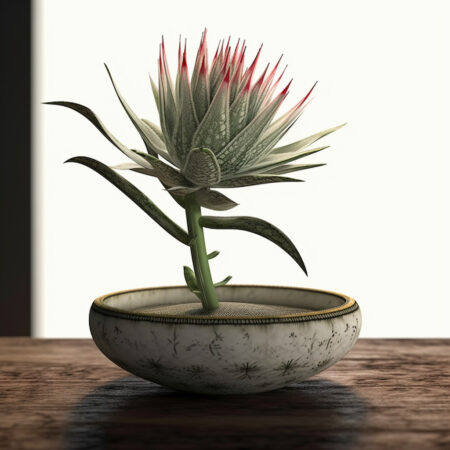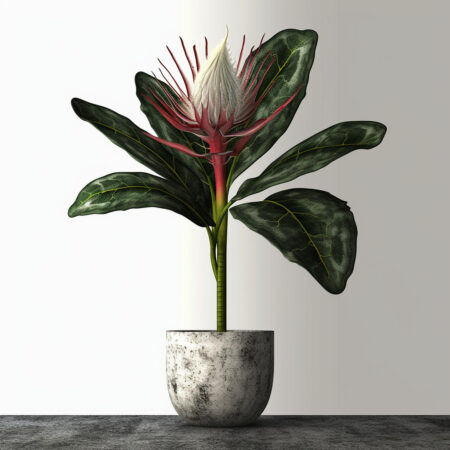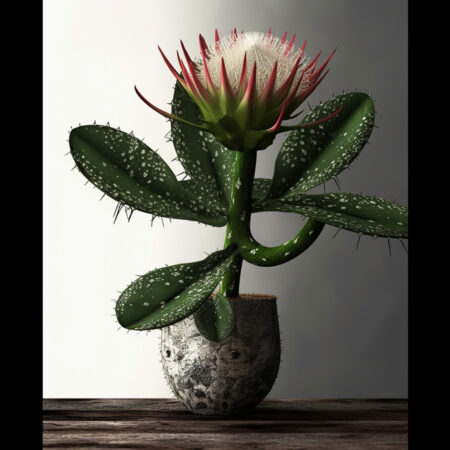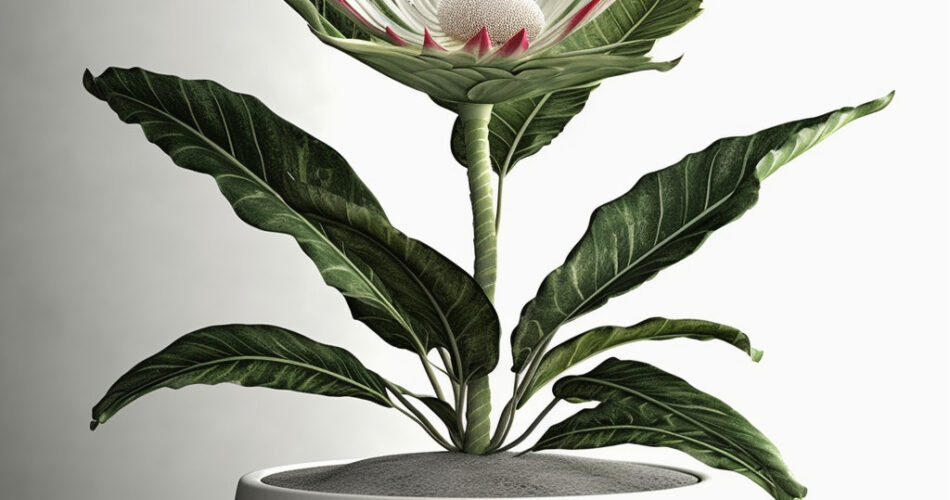Key Takeaways:
- Moonlight Cactus, known as Selenicereus, have stunning flowers that open exclusively at night.
- Selenicereus plants have sprawling growth habits and produce edible fruits known as dragon fruits.
- Temperature drop, increased humidity, and the release of specific chemicals trigger the night-blooming behavior of Selenicereus.
- Choose a Selenicereus variety suitable for your space, considering lighting conditions, temperature, and humidity.
- Selenicereus plants prefer bright but indirect sunlight and well-draining soil.
- Proper watering, fertilizing, pruning, and pest control are essential for the care and maintenance of Selenicereus.
- Selenicereus plants bloom once a year, and their flowers last for a single night to several days.
- To enhance blooming, provide a slightly cooler period, darkness, and consistent care.
- To preserve night blooms, you can take photographs, create pressed arrangements, or dry the flowers using desiccants.
- Selenicereus plants can be propagated through stem cuttings, grafting, or seed propagation.
- Manage common pests like mealybugs, spider mites, aphids, and scale insects with organic insecticidal soap or natural remedies.
- Prevent diseases like root rot and stem rot by avoiding overwatering and providing good airflow.
- Utilize Selenicereus in floral arrangements and maximize their aesthetic appeal in indoor and outdoor designs.
The Allure of Selenicereus: A Moonlight Cactus Beauty
Introduction to the Moonlight Cactus Cactus
Selenicereus, also known as Moonlight Cactus, are a group of cacti known for their enchanting beauty and unique flowering habits. These captivating plants belong to the Cactaceae family and are native to Central and South America. What sets them apart from other cacti is their ability to produce stunning flowers that open exclusively at night, filling the air with a sweet fragrance.
One of the most remarkable features of night-blooming cacti is their adaptation to desert environments. These plants have evolved to thrive in arid conditions, making them excellent choices for those seeking low-maintenance and drought-tolerant additions to their gardens or indoor spaces.
The Fascinating Features of Selenicereus
Selenicereus plants are characterized by their sprawling growth habit, with long, climbing or trailing stems adorned with sharp spines. The stems of some species can reach impressive lengths, making them perfect candidates for hanging baskets or trellises.
One of the most striking attributes of Selenicereus is their flowers. These blooms are typically large and showy, often measuring up to 10 inches in diameter. They come in a variety of colors, including white, cream, yellow, pink, and red. The floral display is truly a sight to behold, with the flowers’ intricate petals and delicate fragrance creating a mesmerizing spectacle.
Another noteworthy feature of Selenicereus is their ability to produce edible fruits. These fruits, known as dragon fruits or pitayas, are elongated and brightly colored. They have a sweet, juicy flesh that is often compared to a combination of kiwi and pear, making them a favorite among fruit enthusiasts.
Unveiling the Mysteries of Moonlight Cactus
The night-blooming behavior of Selenicereus plants is a captivating phenomenon that has intrigued horticulturists and enthusiasts for generations. While many plants rely on sunlight to initiate their blooming process, Selenicereus flowers open in the evening and close by morning, attracting pollinators such as moths and bats.
The exact trigger for the night-blooming behavior is still a subject of scientific research, but several factors are believed to influence it. One theory suggests that a combination of temperature drop and increased humidity during the night stimulates the flowers to open. Another hypothesis proposes that the release of specific chemicals during nighttime triggers the blooming process.
Regardless of the precise mechanism, witnessing the breathtaking transformation of Selenicereus flowers as they unfurl under the cover of darkness is a truly magical experience that evokes a sense of wonder and awe.

Bringing Selenicereus to Life: Growing Tips and Techniques
Choosing the Perfect Selenicereus Variety for Your Space
When selecting a Selenicereus variety for your garden or indoor collection, it’s essential to consider the specific requirements of each species. Some varieties, such as Selenicereus grandiflorus and Selenicereus anthonyanus, are better suited for outdoor cultivation, while others, like Selenicereus chrysocardium and Selenicereus pteranthus, thrive in indoor environments.
Consider the available space and lighting conditions in your home or garden, as well as the average temperature and humidity levels. This information will help you determine which Selenicereus variety is most likely to thrive in your particular setting.
Creating the Ideal Growing Conditions
Selenicereus plants prefer bright but indirect sunlight. Therefore, it’s best to position them near a window that receives filtered light or in a location where they are shaded from intense midday sun. If growing them outdoors, providing a structure or trellis for the plants to climb on can help support their sprawling growth habit.
In terms of soil, Selenicereus plants thrive in a well-draining mix that mimics their natural habitat. A combination of sandy soil, perlite, and organic matter, such as coco coir, creates an ideal environment for their roots to grow and establish. Avoid overwatering, as these cacti are susceptible to root rot in consistently moist conditions.
Temperature and humidity are crucial factors in successfully growing Selenicereus plants. Most species prefer temperatures between 60°F and 80°F (15°C to 27°C) during the growing season, with a slight drop in temperature at night. As for humidity, providing moderate levels, around 40% to 60%, will help replicate their native environment.
Essential Care and Maintenance for Healthy Night-bloomers
Proper care and maintenance are essential to ensure the health and vitality of your Selenicereus plants. Regular watering is necessary, but it’s important to strike the right balance. Water thoroughly when the top inch of soil feels dry, allowing excess water to drain away.
Fertilizing Selenicereus plants during the growing season will promote vigorous growth and increase the likelihood of blooms. Use a balanced, water-soluble fertilizer formulated specifically for cacti and succulents. Apply the fertilizer at half strength every two to four weeks, following the package instructions.
Pruning may be necessary to control the size and shape of your Selenicereus plants. Trim back any overly long or unruly stems, making clean cuts just above a joint or node. These cuttings can be rooted and propagated to expand your collection or share with fellow plant enthusiasts.
Regular monitoring for pests, such as mealybugs or spider mites, is crucial. Inspect your plants thoroughly, paying close attention to the undersides of leaves and stem joints. If pests are detected, treat them promptly using organic insecticidal soap or neem oil, following the instructions on the product label.

Unlocking the Magic of Selenicereus: Flowering and Bloom Care
Understanding the Night-blooming Cycle
The night-blooming cycle of Selenicereus plants is a phenomenon that both surprises and delights gardeners. These plants typically bloom once a year, and the duration of the flowering period can last anywhere from a single night to several days.
When a Selenicereus plant is preparing to bloom, it will produce flower buds that gradually increase in size. Over time, these buds will start showing signs of opening, indicating that the night-blooming spectacle is about to unfold.
As the sun sets and darkness falls, the tight buds of Selenicereus flowers begin to unfurl, revealing their intricate petals and emitting a delightful fragrance. The flowers reach their peak beauty during the early hours of the night, attracting nocturnal pollinators with their sweet scent and vivid colors.
By the following morning, the flowers will start to close, and within a day or two, they will wither and drop off. It’s important to cherish and enjoy the fleeting beauty of these night blooms, as they are truly a marvel of nature.
Encouraging Blooms: Tips for Optimal Flowering
If you’re eager to witness the mesmerizing night blooms of your Selenicereus plants, there are several factors to consider to enhance blooming and ensure optimal flowering.
Firstly, it’s essential to provide your plants with the right environmental conditions. Selenicereus prefer a slightly cooler period with reduced watering during the winter months to mimic their natural dormancy period. This extended rest period will encourage the plants to bloom when the growing season resumes.
Providing a period of darkness for your Selenicereus plants is also crucial. Try to limit artificial light exposure during the evening and night hours to mimic natural conditions. Even small amounts of light pollution can disrupt the blooming process, so cover nearby windows or move your plants to a darker location during the night.
Finally, consistent care and attention to proper watering, fertilizing, and pruning practices will contribute to the overall health and vigor of your Selenicereus plants, increasing their chances of producing abundant and beautiful blooms.
Protecting and Preserving Selenicereus
Preserving the captivating beauty of night blooms can be a rewarding endeavor. If you wish to enjoy the ephemeral splendor of the flowers beyond their bloom time, there are several techniques you can employ to preserve them.
One popular method involves taking photographs or creating pressed flower arrangements. Photographing the blooms with a macro lens allows you to capture their intricate details, while pressing the flowers between heavy books and preserving them in a frame creates a timeless piece of art.
Another technique is to dry the flowers using desiccants like silica gel or drying them naturally by hanging them upside down in a dark, well-ventilated space. Properly dried Selenicereus flowers can be used in various craft projects or added to potpourri mixes, allowing you to enjoy their beauty for years to come.
By preserving night blooms, you can cherish the enchantment of these ephemeral flowers and prolong the magic they bring to your space.
Unveiling the Secrets: Propagation and Reproduction
Techniques for Propagating Moonlight Cactus
Propagating Selenicereus plants can be an exciting and rewarding process. There are several methods you can use to expand your collection or share these captivating plants with fellow enthusiasts.
One common method is stem cuttings. To propagate Selenicereus using stem cuttings, select a healthy, mature stem and make a clean cut just below a joint or node. Allow the cut end to callus for a few days before placing it in a well-draining potting mix. Keep the soil slightly moist, and within a few weeks, roots should develop, indicating successful propagation.
Another propagation technique is grafting. This method involves joining a Selenicereus cutting onto a rootstock of a different cactus species. Grafting can accelerate the growth and development of the cutting, resulting in a more robust and mature plant in a shorter period.
Regardless of the propagation method you choose, it’s essential to provide the newly propagated plants with the same care and growing conditions as the parent plants to ensure their successful establishment.
Troubleshooting Common Propagation Challenges
While propagating Selenicereus plants can be relatively straightforward, there are some challenges you may encounter along the way.
One common issue is unsuccessful root development. If your stem cuttings fail to produce roots, ensure that the cut ends are calloused before planting them in the potting mix. Providing the right amount of moisture is crucial as well. Too much water can cause rotting, while excessive dryness can hinder root formation.
Another challenge is graft failure. If your grafting attempts are unsuccessful, ensure that the cut surfaces of both the cutting and rootstock are clean and fit together snugly. It’s also important to secure the graft with grafting tape or other suitable materials to promote a successful union.
Patience is key when propagating Moonlight Cactus. Some cuttings may take longer to produce roots or establish themselves, but with consistent care and attention, you can overcome these challenges and enjoy the rewards of successful propagation.
Expanding Your Collection: Reproduction Methods and Tips
If you’re passionate about expanding your Selenicereus collection beyond the traditional propagation methods, there are other reproduction techniques you can explore to introduce new varieties and cultivars.
The most common method is seed propagation. Moonlight Cactus produce seeds after successful pollination. Collect the ripe fruits and extract the seeds, ensuring they are clean and free from any debris. Sow the seeds in a well-draining soil mix, and cover them lightly with a thin layer of soil. Place the container in a warm and bright location, keeping the soil moist but not overly wet. Within a few weeks, the seeds should germinate, and you can witness the growth of new Selenicereus seedlings.
Additionally, hybridization techniques can be used to create new and unique Selenicereus varieties. This method involves controlled cross-pollination between different Selenicereus species or even other cactus species. By carefully selecting the parent plants, you can introduce new traits and characteristics, resulting in offspring with a combination of desirable features.
When experimenting with reproduction methods, it’s important to keep detailed records of your process and observations. This will help you track the progress and results of your endeavors, allowing for continuous improvement and potential breakthroughs in Selenicereus breeding.

The Journey of a Moonlight Cactus: Pests, Diseases, and Remedies
Identifying and Managing Common Pests
While Selenicereus plants are generally resilient, they can still fall victim to various pests that can affect their overall health and vigor.
One common pest is the mealybug, which appears as small, cottony masses on the plant’s stems and leaves. To manage mealybug infestations, use a cotton swab dipped in rubbing alcohol to remove the pests, or apply an organic insecticidal soap or neem oil spray, ensuring thorough coverage of the affected areas.
Spider mites can also pose a threat to Selenicereus plants, especially in dry and dusty conditions. These tiny pests create fine webbing on the plant’s leaves and feed on the sap, causing discoloration and stunted growth. Regularly misting your plants and keeping the relative humidity levels up can deter spider mites. If an infestation occurs, use a forceful stream of water to dislodge the mites or apply an appropriate insecticidal soap or miticide.
Aphids and scale insects are additional pests that can affect Selenicereus plants. These insects suck the plant’s sap, causing leaf distortion and yellowing. To manage aphids and scales, similar methods can be used as with other pests, such as spraying with insecticidal soap or rubbing alcohol, or using a horticultural oil spray.
Recognizing and Treating Potential Diseases
While Selenicereus plants are relatively resistant to diseases, certain conditions can lead to the development of fungal or bacterial infections.
One common disease is root rot, which is caused by overwatering or poor drainage. Infected plants exhibit wilting, yellowing, and softening of the stems and roots. To prevent root rot, ensure your plants are in well-draining soil and water them sparingly, allowing the soil to dry out between waterings. If root rot is suspected, remove the affected portions and repot the plant in fresh, dry soil.
Another potential issue is stem rot, which can occur if the plant sustains physical damage or is exposed to excessively wet conditions. Infected stems develop soft spots, discoloration, and a foul odor. To prevent stem rot, avoid excessive watering and provide proper support to prevent the stems from bending or breaking.
If you notice any unusual symptoms or signs of disease, it’s important to promptly identify and treat the issue. Consult with a local plant expert or horticulturist for proper diagnosis and appropriate treatment recommendations.
Natural Remedies for a Vibrant and Healthy Selenicereus
In addition to managing pests and diseases, maintaining the overall health and vitality of your Selenicereus plants can also benefit from natural remedies and preventive measures.
A natural approach to fertilization involves incorporating organic matter into the soil, such as well-rotted compost or composted manure. This provides a slow-release source of nutrients, promoting healthy growth without the risk of chemical burns or nutrient imbalances.
Another natural remedy is the use of beneficial insects. For example, introducing ladybugs or lacewings to your garden or indoor space can help control aphid populations and other pests that may target Selenicereus plants.
Additionally, promoting good airflow and ventilation around your plants can help prevent the development of fungal diseases. Avoid overcrowding and provide adequate spacing between plants to allow for air circulation. Pruning any excess foliage or stems can also help improve air movement and reduce the risk of fungal infections.
Going Beyond: Creative Uses and Enhancing Your Space
Utilizing Moonlight Cactus in Floral Arrangements
The exquisite beauty and unique flowering habits of Selenicereus make them excellent choices for incorporating into floral arrangements and event decorations.
The large, showy blooms of Selenicereus can serve as stunning focal points or provide a touch of drama and elegance to bouquets and centerpieces. Their night-blooming nature adds an air of mystery and enchantment to any floral arrangement, making them a popular choice for weddings or special occasions.
When using Selenicereus flowers in floral arrangements, it’s best to harvest them just before they fully open in the evening. Remove any thorns or spines from the stems and place the cut flowers in fresh water with floral preservatives to prolong their display.
Maximizing the Aesthetic Appeal of Selenicereus
Selenicereus plants have a unique aesthetic appeal that can enhance any space, whether it’s a garden, patio, or indoor area.
To maximize the visual impact of Selenicereus plants, consider planting them in hanging baskets or allowing them to climb on trellises or pergolas. Their long, trailing stems adorned with sharp spines create a visually striking display, especially when the plants produce their exquisite night blooms.
Pairing Selenicereus with other succulents or cacti can create a captivating composition, utilizing varying textures and forms. Combine different species with contrasting growth habits or flower colors to create a visually stunning and dynamic display.
Incorporating Night-bloomers into Indoor and Outdoor Designs
Selenicereus plants can be seamlessly integrated into both indoor and outdoor designs, adding a touch of exotic beauty and interest to any space.
For indoor spaces, consider placing Selenicereus in well-lit areas near windows or under skylights, ensuring they receive bright but indirect light. Their sprawling growth habit and impressive flower displays can serve as focal points in living rooms, entryways, or conservatories.
In outdoor gardens, Moonlight Cactus can be used to create living walls or green screens. Train their long stems to climb on trellises or wire structures, creating a natural and visually appealing barrier or backdrop. Pair them with other climbers or trailing plants to add depth and texture to vertical gardens or pergolas.
Regardless of how you choose to incorporate Selenicereus into your designs, their charm and allure are sure to captivate and inspire, creating a truly enchanting atmosphere.
FAQ
1. Question: What makes Selenicereus different from other cacti?
Answer: Selenicereus, also known as night-blooming cacti, produce stunning flowers that open exclusively at night and have adapted to thrive in arid conditions.
2. Question: How long do Selenicereus flowers bloom?
Answer: Selenicereus flowers bloom once a year and can last for a single night to several days.
3. Question: What triggers the night-blooming behavior of Selenicereus?
Answer: The exact triggers are still being researched, but it is believed that temperature drop, increased humidity, and the release of specific chemicals during nighttime stimulate the blooming process.
4. Question: How should Selenicereus be cared for during the growing season?
Answer: Selenicereus plants should be placed in bright but indirect sunlight, watered when the top inch of soil is dry, and fertilized with a balanced, water-soluble fertilizer formulated for cacti and succulents every two to four weeks.
5. Question: Can Selenicereus flowers be preserved?
Answer: Yes, Selenicereus flowers can be preserved by taking photographs, creating pressed arrangements, or drying them using desiccants like silica gel or by hanging them upside down in a dark, well-ventilated space.
6. Question: How can Selenicereus be propagated?
Answer: Selenicereus can be propagated through stem cuttings, grafting, or seed propagation.
7. Question: What are common pests and diseases that affect Selenicereus plants?
Answer: Common pests include mealybugs, spider mites, aphids, and scale insects. Diseases such as root rot and stem rot can occur due to overwatering or poor drainage.
8. Question: What are natural remedies for maintaining the health and vigor of Selenicereus plants?
Answer: Natural remedies include incorporating organic matter into the soil, introducing beneficial insects, and promoting good airflow and ventilation.




Comments